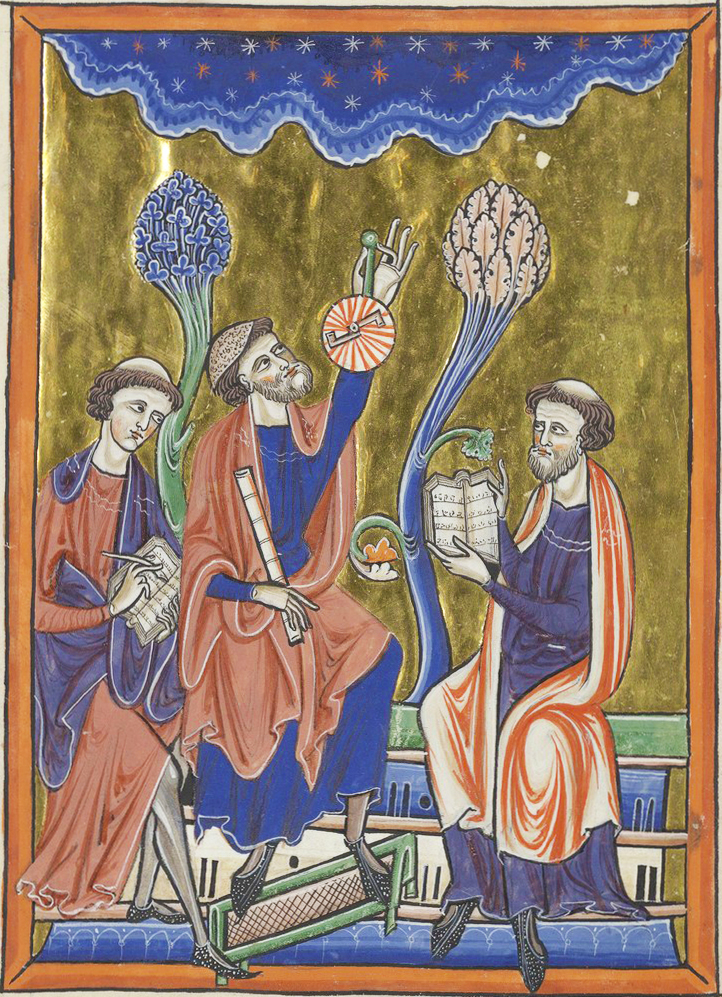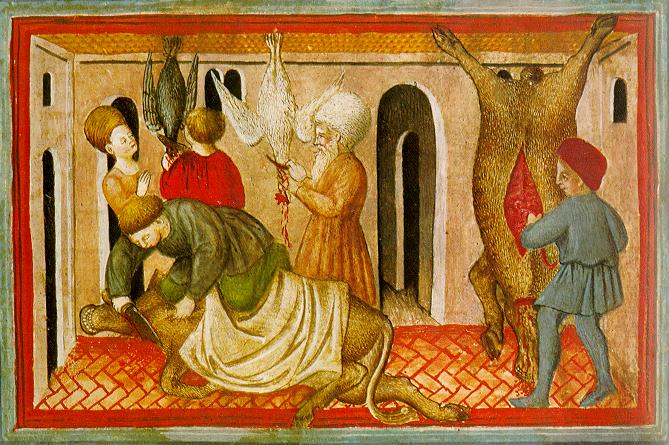|
Judah Ben Benjamin Anav
Rabbi Judah ben Benjamin Anav (Hebrew: יהודה בן בנימין ענו or ריבב"ן; approximately 1215-1280) was one of the Rishonim in Italy. He wrote a known commentary on the main book of Isaac Alfasi, a commentary to tractate Shekalim of the Mishna and on Sheiltot by Achai Gaon.Anav, Judah ben Benjamin Ha-Rofe '''' He also wrote a book about and Terefah. [...More Info...] [...Related Items...] OR: [Wikipedia] [Google] [Baidu] |
Rishonim
''Rishonim'' (; ; sing. , ''Rishon'') were the leading rabbis and ''posek, poskim'' who lived approximately during the 11th to 15th centuries, in the era before the writing of the ''Shulchan Aruch'' (, "Set Table", a common printed code of Jewish law, 1563 CE) and following the ''Geonim'' (589–1038 CE). Rabbinic scholars subsequent to the ''Shulchan Aruch'' are generally known as ''acharonim'' ("the latter ones"). The distinction between the and the is meaningful historically; in ''halakha'' (Jewish law) the distinction is less important. According to a widely held view in Orthodox Judaism, the Acharonim generally cannot dispute the rulings of rabbis of previous eras unless they find support from other rabbis in previous eras. On the other hand, this view is not formally a part of ''halakha'' itself, and according to some rabbis is a violation of the halakhic system.See Kesef Mishna (Maamrim 2:2), Kovetz Igros Chazon Ish (2:26) In ''The Principles of Jewish Law'', Orthodox ra ... [...More Info...] [...Related Items...] OR: [Wikipedia] [Google] [Baidu] |
Isaac Alfasi
Isaac ben Jacob Alfasi (1013–1103) (, ), also known as the Alfasi or by his Hebrew acronym, the Rif (Rabbi Isaac al-Fasi), was a Maghrebi Talmudist and posek (decider in matters of halakha, Jewish law). He is best known for his work of ''halakha'', the legal code Sefer Ha-halachot, considered the first fundamental work in ''halakhic'' literature. Biography He was born in Qal'at Bani Hammad in modern-day Algeria, capital city of the Sanhaja Hammadid dynasty of the central Maghreb, and is therefore sometimes called "ha-Kala'i." Some older sources believe Qalaat Hammad refers to a village near Fez. He studied in Kairouan, Tunisia under Nissim ben Jacob, and Chananel ben Chushiel the recognized rabbinical authorities of the age. Chananel trained Alfasi to deduce and to clarify the Halakha from Talmudic sources, and Alfasi then conceived of the idea of compiling a comprehensive work that would present all of the practical conclusions of the Gemara in a clear, definit ... [...More Info...] [...Related Items...] OR: [Wikipedia] [Google] [Baidu] |
Shekalim
A shekel or sheqel (; , , plural , ) is an ancient Mesopotamian coin, usually of silver. A shekel was first a unit of weight—very roughly 11 grams (0.35 ozt)—and became currency in ancient Tyre, Carthage and Hasmonean Judea. Name The word is based on the triliteral Proto-Semitic root , cognate to the Akkadian or , a unit of weight equivalent to the Sumerian . Use of the word was first attested in under the reign of Naram-Sin of Akkad, and later in in the Code of Hammurabi. The Hebrew reflex of the root is found in the Hebrew words for "to weigh" (), "weight" () and "consideration" (). It is cognate to the Aramaic root and the Arabic root ( ث ق ل, in words such as "weight", "heavy" or , a unit of weight). The famous writing on the wall in the Book of Daniel includes a cryptic use of the word in Aramaic: "". Shekel came into the English language via the Hebrew Bible, where it is first used in Genesis 23. The term "shekel" has been used for a unit of weight, ... [...More Info...] [...Related Items...] OR: [Wikipedia] [Google] [Baidu] |
Mishna
The Mishnah or the Mishna (; , from the verb ''šānā'', "to study and review", also "secondary") is the first written collection of the Jewish oral traditions that are known as the Oral Torah. Having been collected in the 3rd century CE, it is the first work of rabbinic literature, written primarily in Mishnaic Hebrew but also partly in Jewish Palestinian Aramaic. The oldest surviving physical fragments of it are from the 6th to 7th centuries. The Mishnah was redacted by Judah ha-Nasi probably in Beit Shearim or Sepphoris between the ending of the second century CE and the beginning of the third century. Heinrich Graetz, dissenting, places the Mishnah's compilation in 189 CE (see: H. Graetz, ''History of the Jews'', vol. 6, Philadelphia 1898, p105), and which date follows that penned by Rabbi Abraham ben David in his "Sefer HaKabbalah le-Ravad", or what was then ''anno'' 500 of the Seleucid era. in a time when the persecution of Jews and the passage of time raised the po ... [...More Info...] [...Related Items...] OR: [Wikipedia] [Google] [Baidu] |
Sheiltot
She'iltot of Rav Achai Gaon, also known as Sheiltot de-Rav Ahai, or simply She'iltot (), is a rabbinic halakhic work composed in the 8th century by Ahai of Shabha (variants: Aḥa of Shabha; Acha of Shabcha), during the geonic period. ''She'iltot'' is an Aramaic word, meaning "Inquiries" or "Quæstiones" (in the sense of disquisitions) and is arranged in order of the biblical pericopes, or weekly Torah readings. The ''She'iltot'' is one of the earliest rabbinic works composed after the Talmud. Place of composition According to Abraham ibn Daud, Aḥai of Shabha completed his ''She'iltot'' between the years 741 and 763 CE, a timeframe corroborated by Sherira ben Hanina in his ''Iggeret of Rabbi Sherira Gaon, Iggeret''.Sherira Gaon (1988), p. 127 (Chapter 12: The Geonic Period) It is unclear whether he compiled his work in indigenous Israel or in Lower Mesopotamia (called "Babylonia"), although it is without question that he moved from Babylonia to indigenous Israel around the t ... [...More Info...] [...Related Items...] OR: [Wikipedia] [Google] [Baidu] |
Achai Gaon
Achai Gaon (also known as Ahai of Shabḥa or Aha of Shabḥa, Hebrew: רב אחא �חאימשַׁבָּחָא) was a leading scholar during the period of the Geonim, an 8th-century Talmudist of high renown. He enjoys the distinction of being the first rabbinical author known to history after the completion of the Talmud. Ahai of Shabha is the author of the ''She'iltot''. As he never actually became the Gaon of either of the two academies, the description "Gaon" attached to his name is a misnomer. When the gaon of Pumbedita died, Aḥa was universally acknowledged to be the fittest man to succeed him. But a personal grudge entertained by the exilarch Solomon bar Ḥasdai induced the latter to pass over Aḥa, and to appoint Natroi Kahana ben Amuna, Aḥa's underling, a man considerably his inferior in learning and general acquirements. Angered by this slight, Aḥa left Babylonia and settled in Israel, about 752 or 753, where he remained until his death. Despite Steinschneider ... [...More Info...] [...Related Items...] OR: [Wikipedia] [Google] [Baidu] |
Encyclopaedia Judaica
The ''Encyclopaedia Judaica'' is a multi-volume English-language encyclopedia of the Jewish people, Judaism, and Israel. It covers diverse areas of the Jewish world and civilization, including Jewish history of all eras, culture, Jewish holiday, holidays, Hebrew language, language, Torah, scripture, and Halakha, religious teachings. First published in 1971–1972, by 2010 it had been published in two editions accompanied by a few revisions. The ''Encyclopaedia Judaica'' was also published on CD-ROM. The CD-ROM version has been enhanced by at least 100,000 hyperlinks and several other features, including videos, slide shows, maps, music and Hebrew pronunciations. While the CD-ROM version is still available, the publisher has discontinued producing new copies for sale. The encyclopedia was written by Israelis, Israeli, Americans, American and European professional subject specialists. History Preceding attempts Between 1901 and 1906 ''The Jewish Encyclopedia'' had been publishe ... [...More Info...] [...Related Items...] OR: [Wikipedia] [Google] [Baidu] |
Shechita
In Judaism, ''shechita'' (anglicized: ; ; ; also transliterated ''shehitah, shechitah, shehita'') is ritual slaughtering of certain mammals and birds for food according to ''kashrut''. One who practices this, a kosher butcher is called a ''shochet''. Biblical sources Deuteronomy 12:21 states that sheep and cattle should be slaughtered "as I have instructed you", but nowhere in the Torah are any of the practices of ''shechita'' described. Instead, they have been handed down in Rabbinic Judaism's Oral Torah, and codified in ''halakha''. Species The animal must be of a permitted species. For mammals, this is restricted to ruminants which have split hooves. For birds, although biblically any species of bird not specifically excluded in Deuteronomy 14:12–18 would be permitted, doubts as to the identity and scope of the species on the biblical list led to rabbinical law permitting only birds with a tradition of being permissible. Fish do not require kosher slaughter to be ... [...More Info...] [...Related Items...] OR: [Wikipedia] [Google] [Baidu] |
Terefah
Terefah (, lit. "torn by a beast of prey"; plural ''treifot'') refers to either: * A member of a kosher species of mammal or bird, disqualified from being considered kosher, due to pre-existing mortal injuries or physical defects. * A specific list of mortal injuries or physical defects that disqualify a member of a kosher species of mammal or bird from being kosher. Biblical prohibition The biblical prohibition of eating ''terefah'' stems from the verse: According to the Talmud, there were originally only eight types of terefah, however, the author(s) of the Mishnah added eighteen items to the list. Eventually, Maimonides added even more to finish the list of terefah conditions at 70. Rabbi Joseph Caro organized all of these symptoms in the Shulchan Aruch ( Yoreh De'ah, 29-60) by categorizing them according to parts of the animal, their minute malady, and any disease, fracture, or abnormality they may possess.The Jewish Encyclopedia. Funk and Wagnalls Company. New ed., Vol ... [...More Info...] [...Related Items...] OR: [Wikipedia] [Google] [Baidu] |
Zedekiah Ben Abraham Anaw
Zedekiah ben Abraham Anaw (13th century; also known by the surname HaRofeh) was an author of halakhic works and younger brother of Benjamin ben Abraham Anaw. He lived at Rome and received his Talmudic training not only in Rome but also in Germany where he was the pupil of Jacob of Würzburg and possibly also of Abigdor Cohen of Vienna. ''Shibbolei haLeket'' He owes his reputation to his compilation of ritual law entitled ''Shibbolei haLeket'' (Ears of Gleaning). It is divided into 372 paragraphs forming twelve sections, covering the laws, regulations, and ceremonies relating to prayers, Sabbath, blessings, and the Jewish holidays. Appended to the work are several treatises and responsa on miscellaneous religious and legal matters, such as circumcision, mourning rites, tzitzit, shechita, inheritance, and interest. As the title indicates, and as the author never fails to point out, the material is not original but rather was culled from many older authorities, such as '' Halakot Ge ... [...More Info...] [...Related Items...] OR: [Wikipedia] [Google] [Baidu] |



